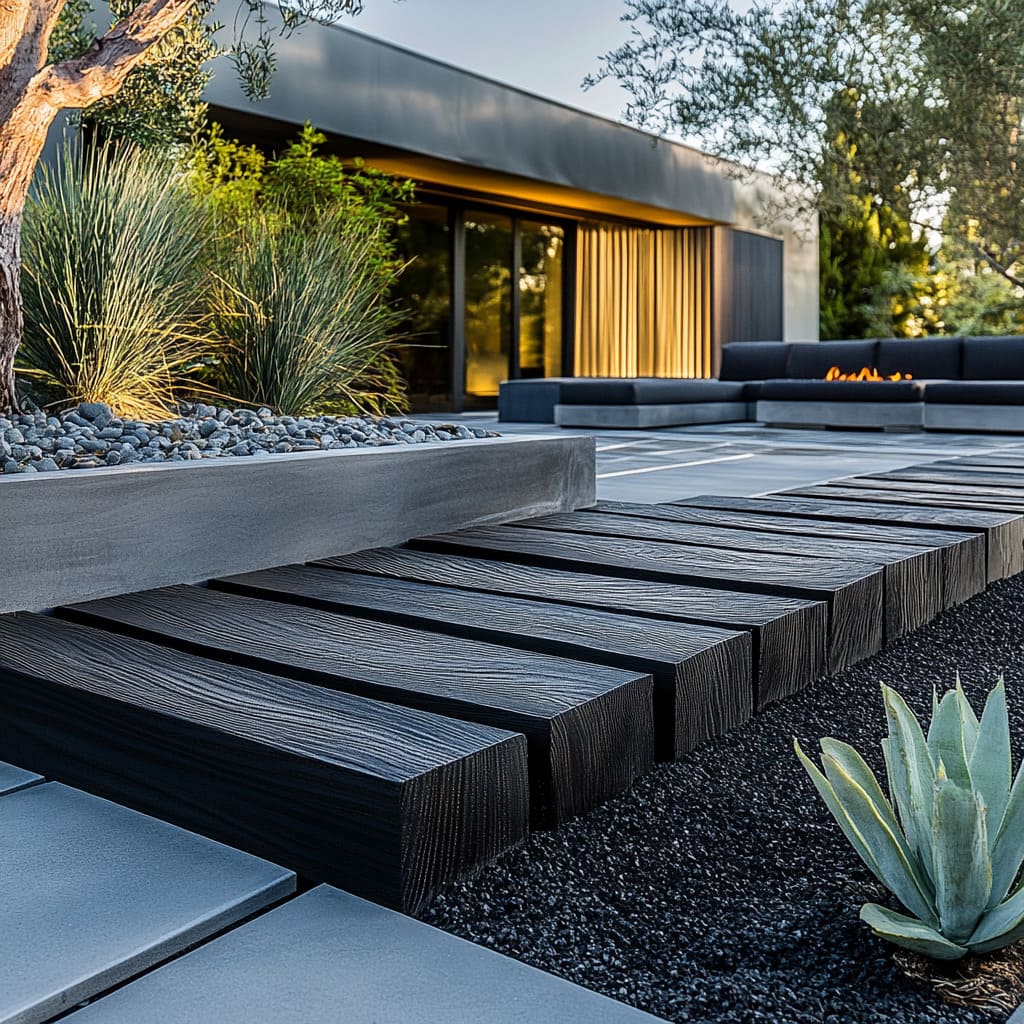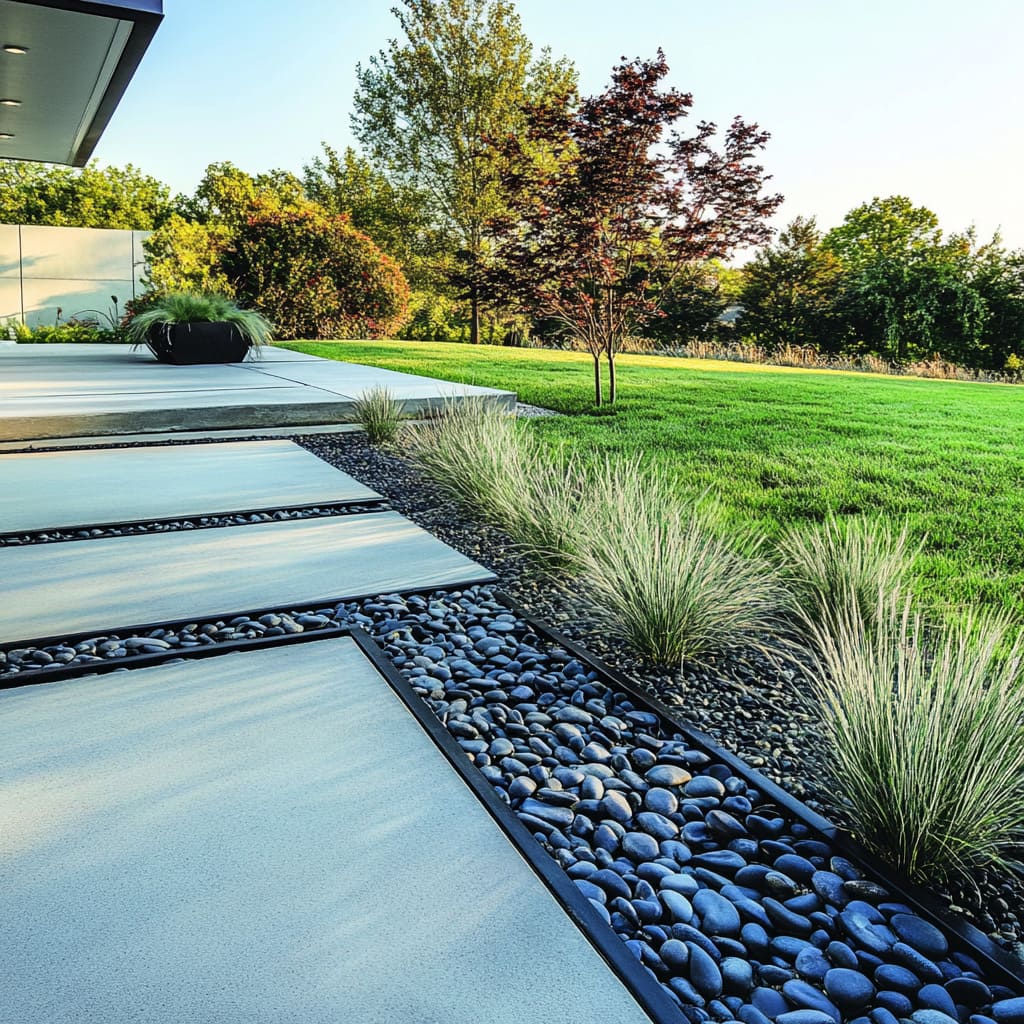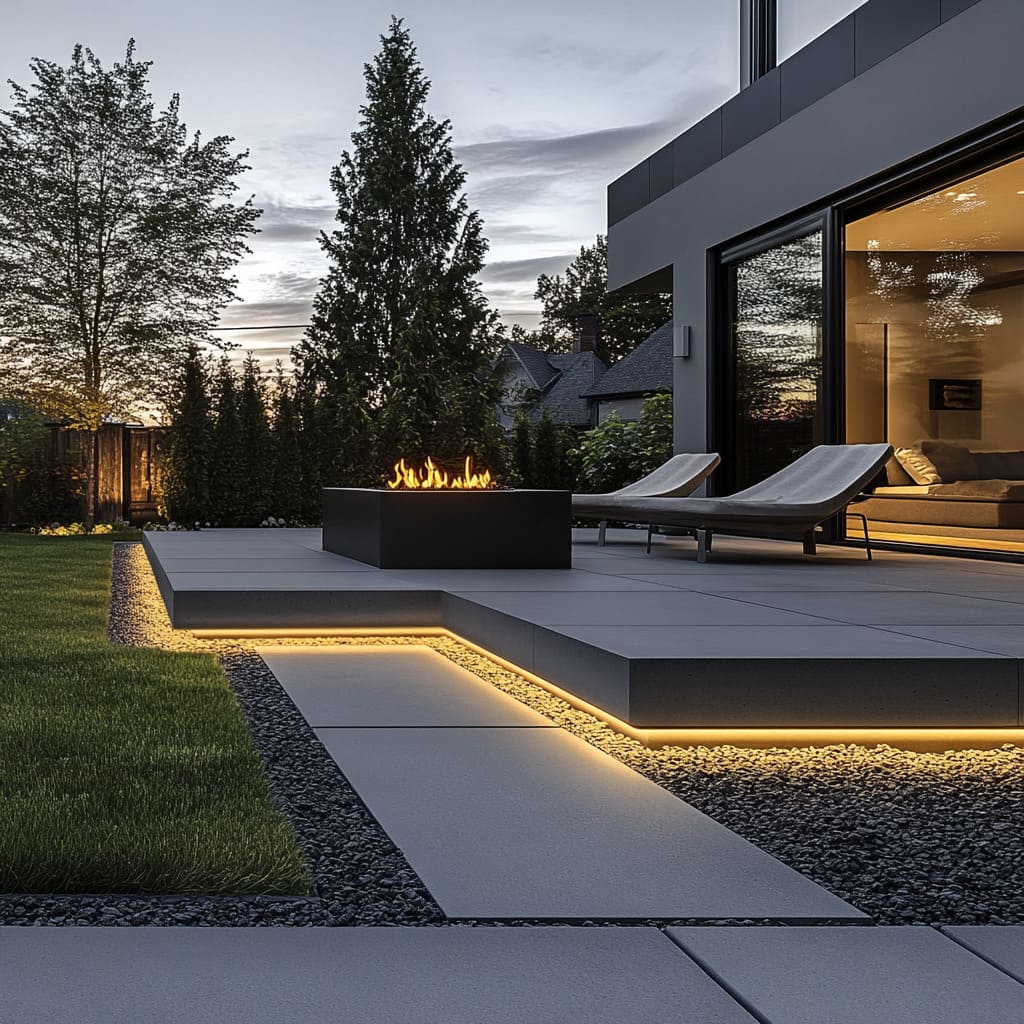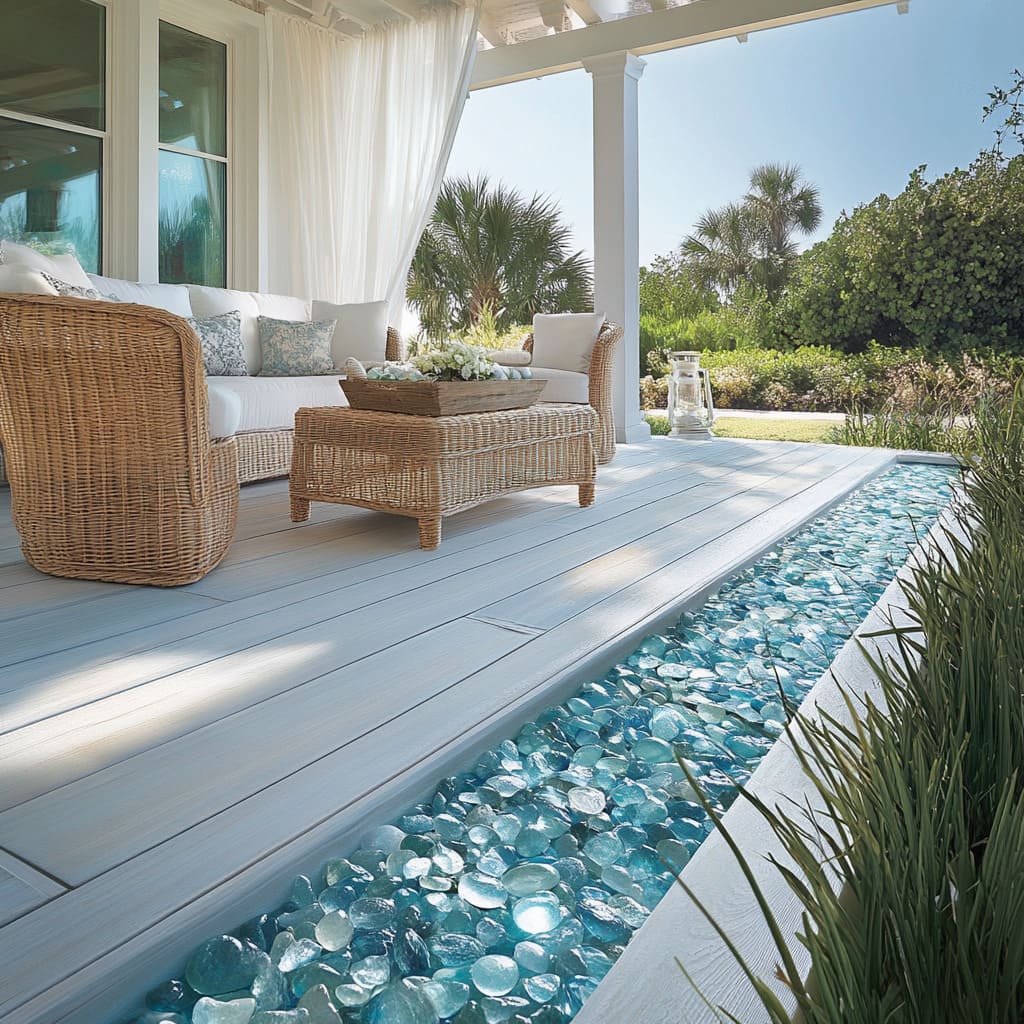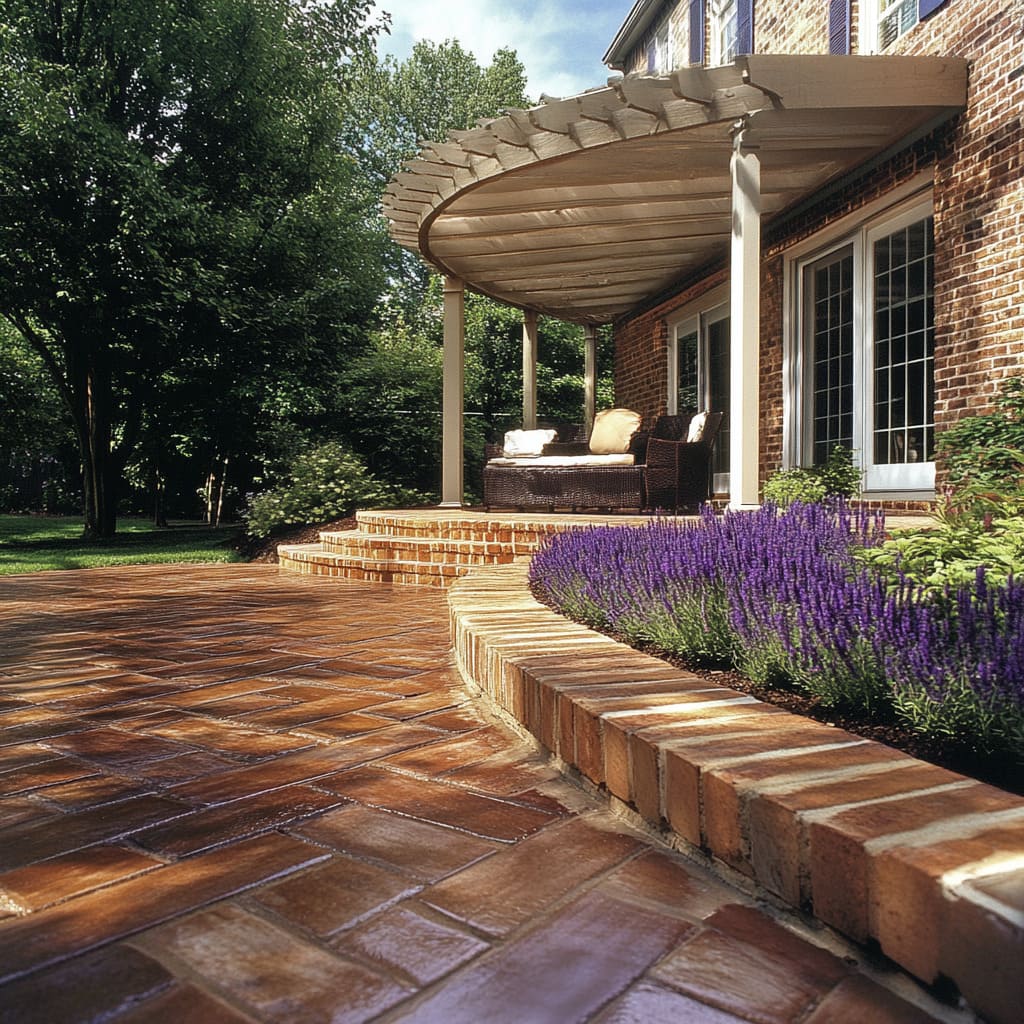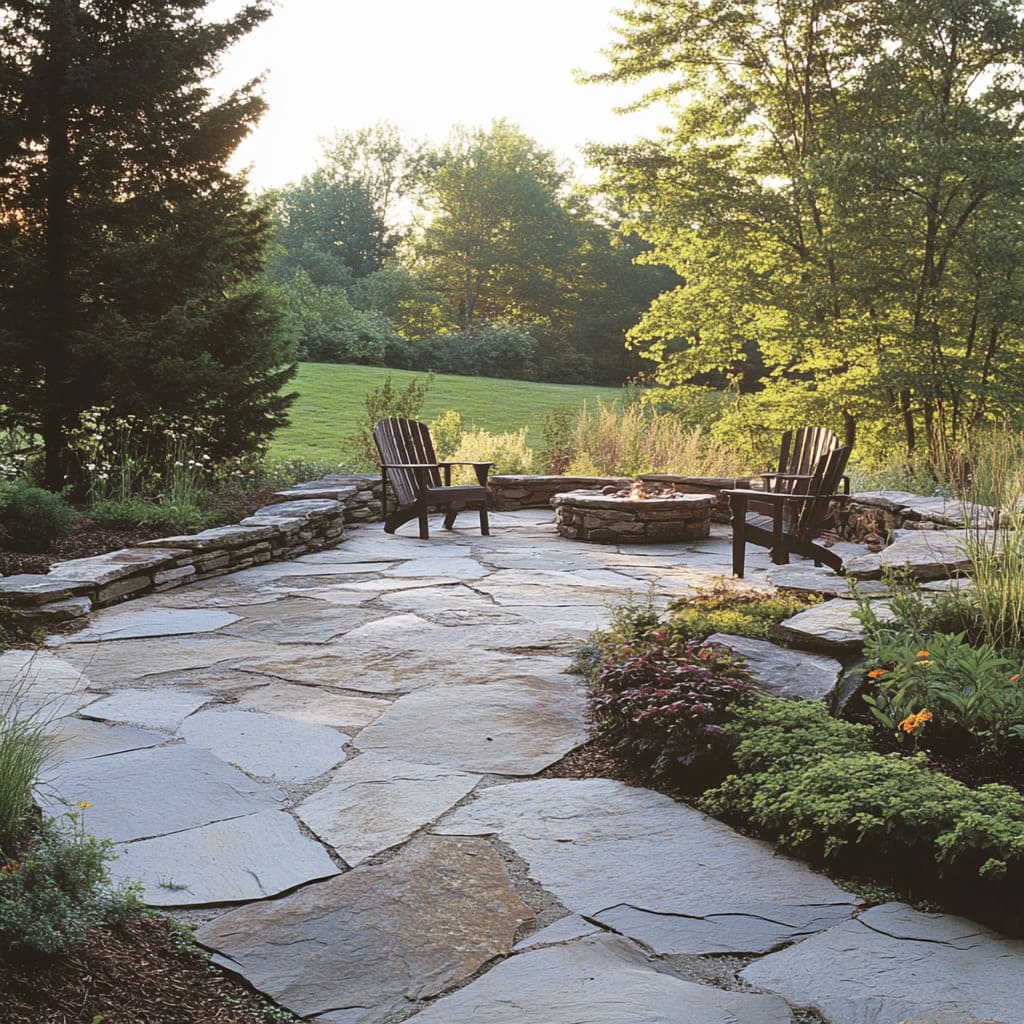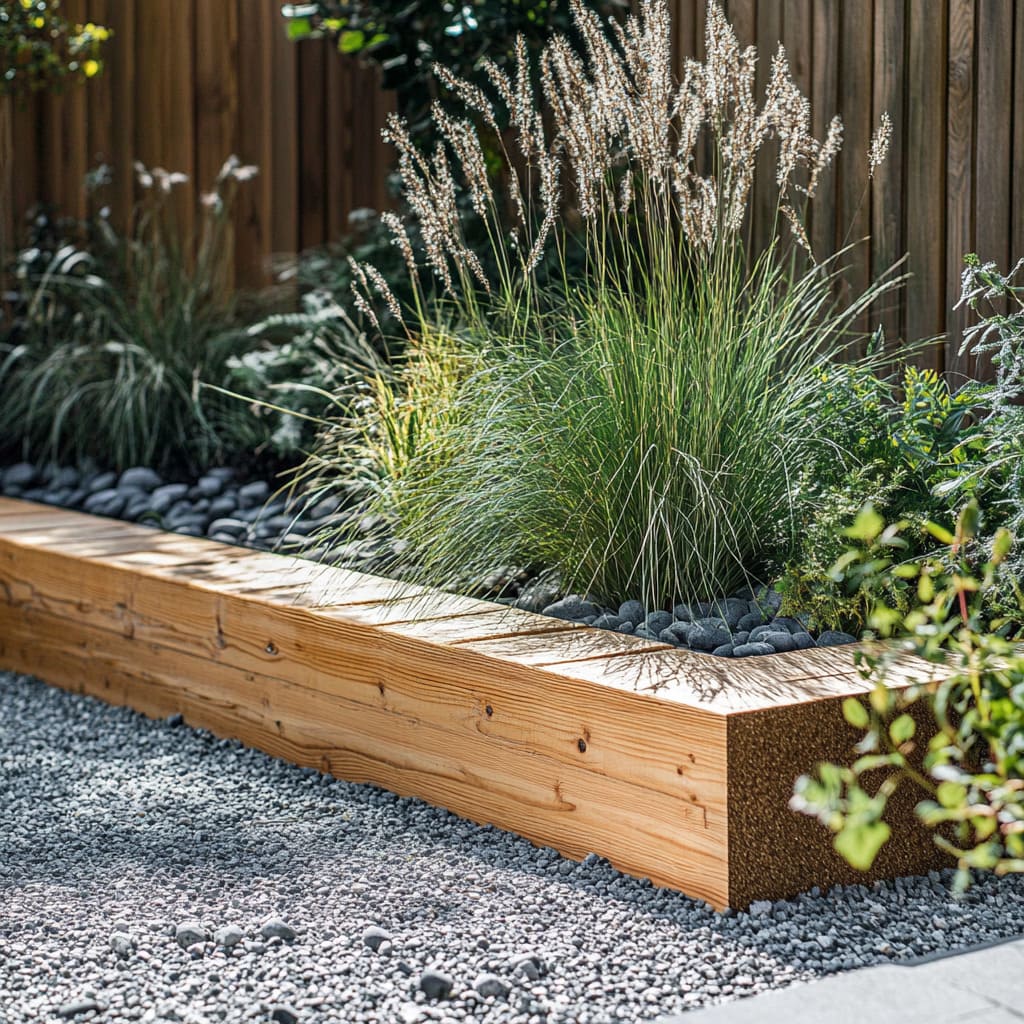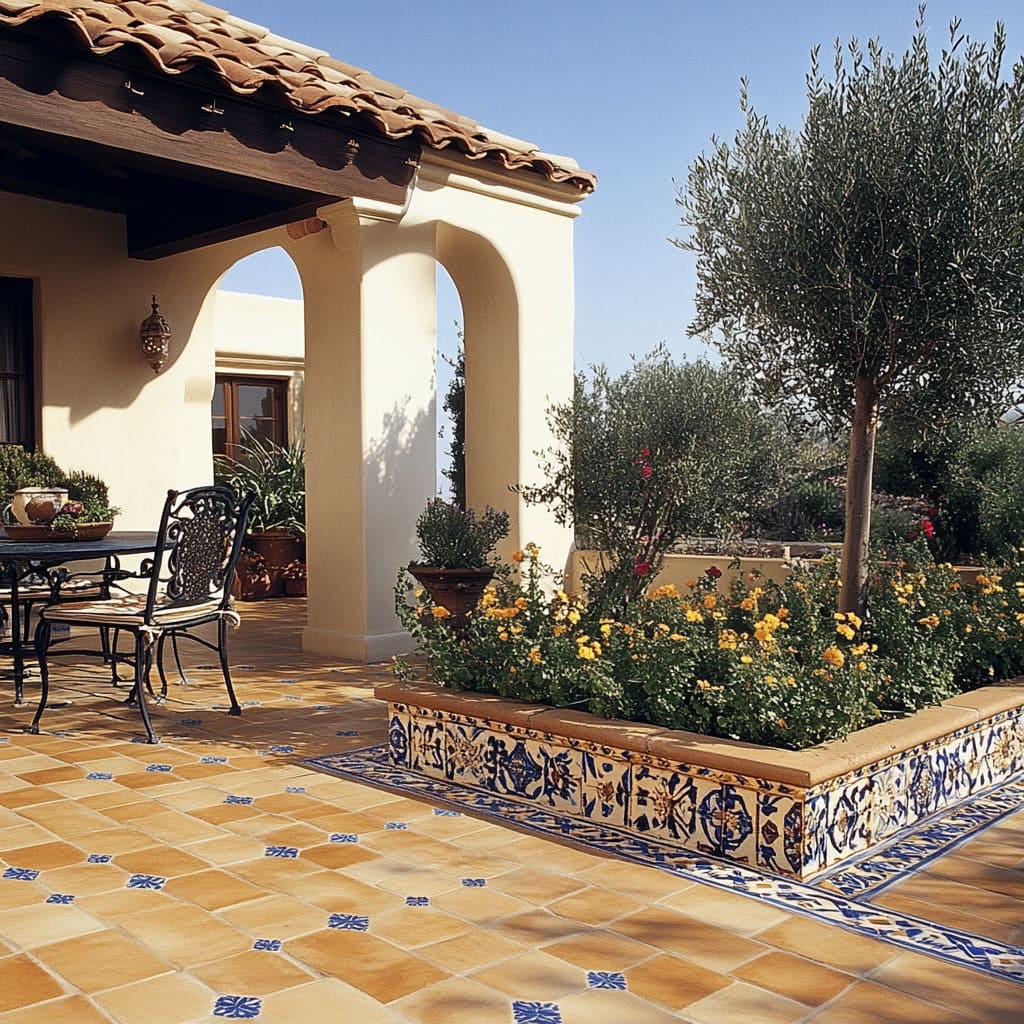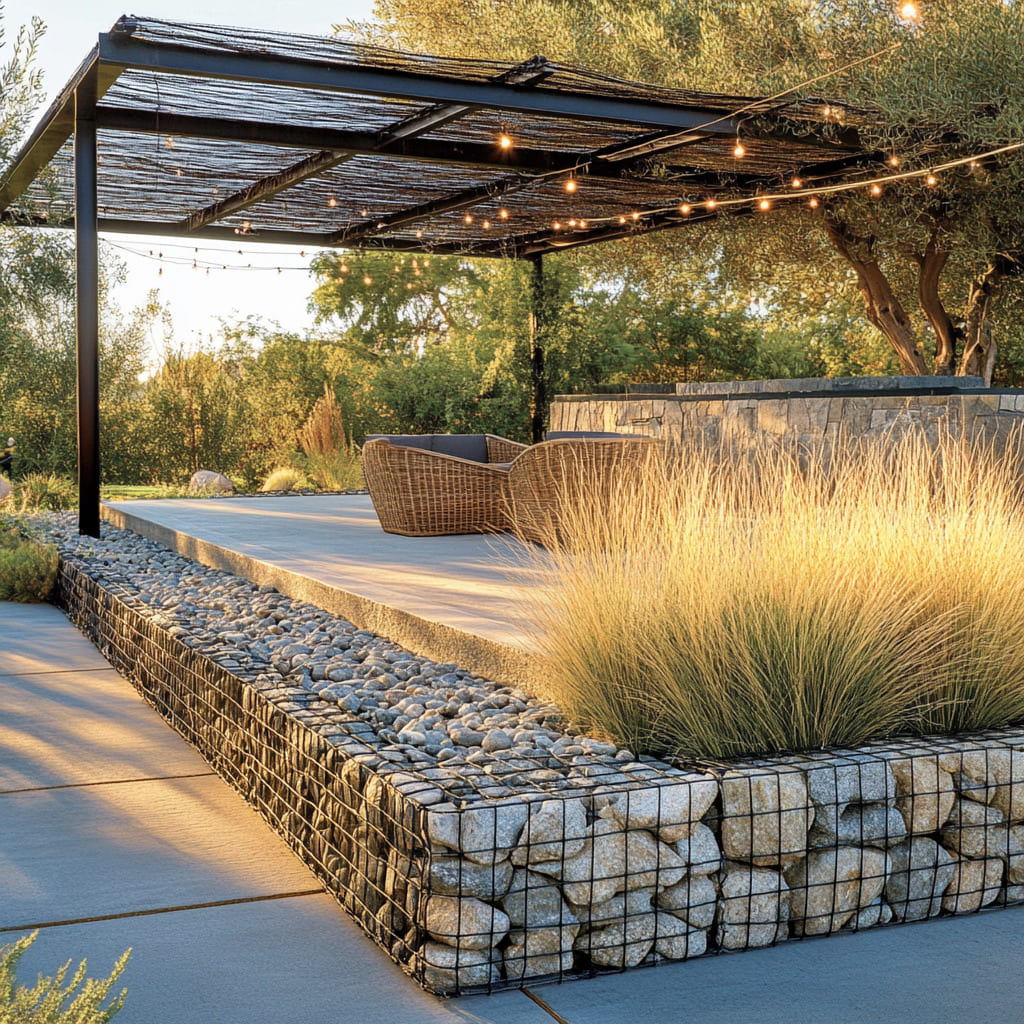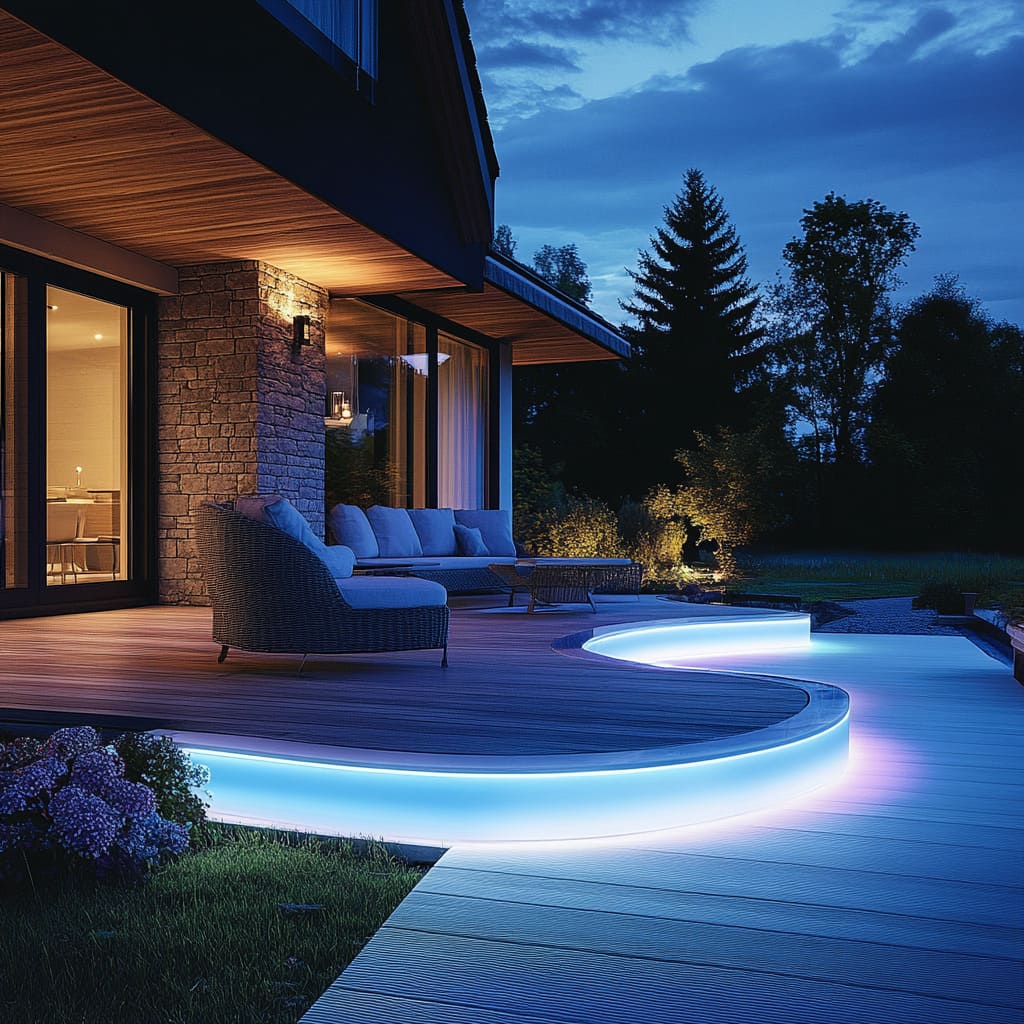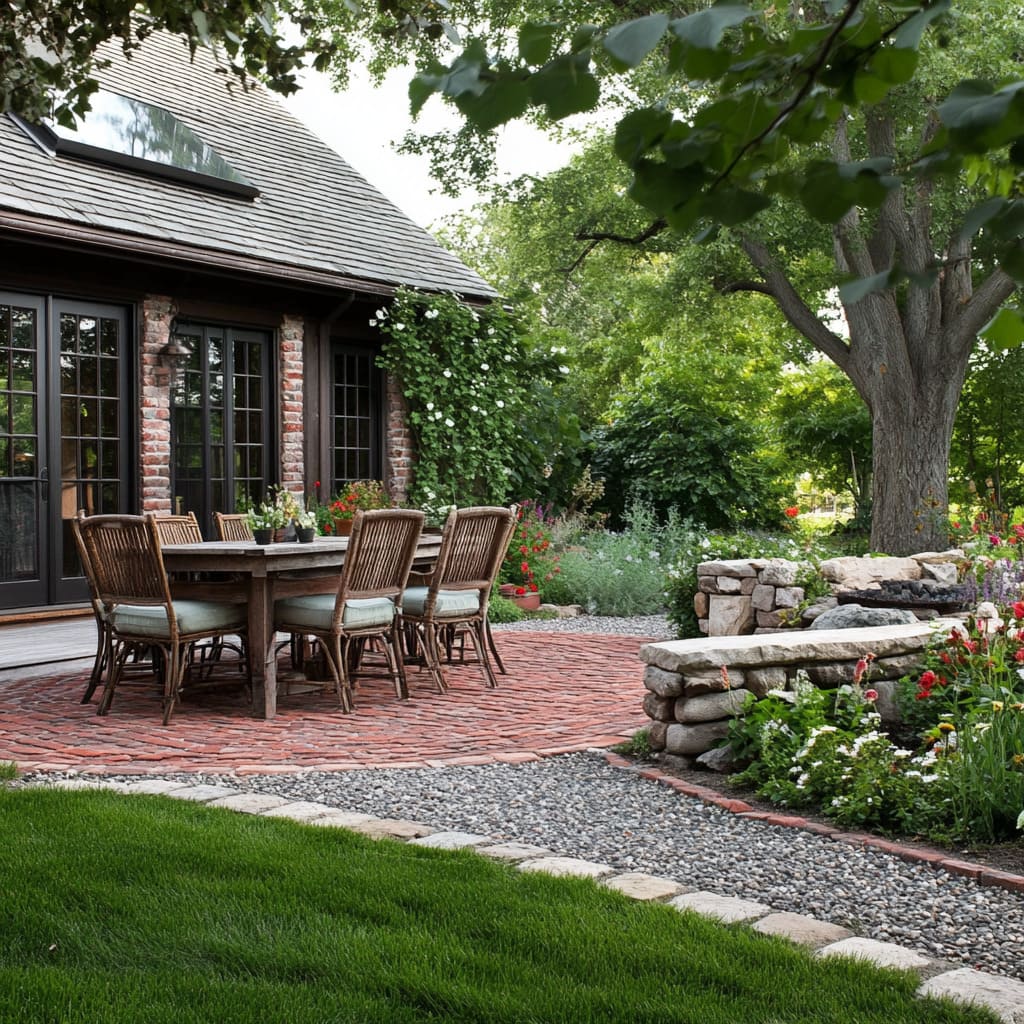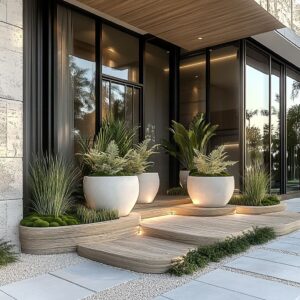Creating a well-defined patio space goes beyond choosing the right furniture and plants—it starts with the edging. The way you frame your patio can influence everything from how spacious it feels to how seamlessly it blends with the surrounding landscape.
This article takes a close look at patio edging ideas, breaking down the details that often go unnoticed but make a huge difference in both design and functionality. Whether you prefer a coastal-inspired retreat, a sleek modern layout, or a timeless brick border, understanding these small but impactful choices can help refine your outdoor space.
Clean-Lined Metal Edging
A sharp, structured border can completely redefine a patio’s look, and metal edging is one of the best ways to achieve that. Whether it’s the industrial richness of Corten steel or the sleek simplicity of black aluminum, this edging style creates a crisp divide between surfaces while keeping the design lightweight and refined.
✔ Best For:
- Modern patios that emphasize clean lines and geometric layouts.
- Industrial-style outdoor spaces where raw textures and bold materials take center stage.
- Minimalist designs that need definition without adding visual weight.
✔ Why It’s Trendy:
- Defined, polished look – Metal creates a straight, uninterrupted edge, making patios feel structured and intentional.
- Corten steel’s evolving texture – Over time, Corten steel develops a rusted patina that blends beautifully with natural elements, adding depth and contrast.
- Seamless blend with modern materials – Aluminum, especially black powder-coated, works well alongside smooth concrete, large-format pavers, or gravel, creating a sleek transition.
- Minimal upkeep – Unlike wood, which can rot, or brick, which may shift over time, metal edging is highly resistant to weather and requires little maintenance.
👉 How to Use It:
- For a bold industrial feel, Corten steel pairs well with large concrete pavers, especially in patios with a raw, modern aesthetic.
- Black aluminum edging works well in patios with a minimalist layout, especially when set against stone or sleek decking.
- To soften the contrast, incorporate ornamental grasses or low-growing plants along the metal edge, blending structure with organic textures.
LED-Embedded Concrete Edging for a Futuristic Glow
Outdoor lighting isn’t just for pathways or wall fixtures—integrating LED strips into patio edges adds a subtle yet powerful effect that enhances both style and functionality. Whether it’s for better nighttime visibility or to highlight architectural details, this type of edging creates a seamless, polished look that blends effortlessly with modern outdoor spaces.
✔ Best For:
- Contemporary patios with geometric layouts and defined borders.
- Smart home outdoor setups where lighting is automated for convenience.
- Spaces that need discreet but effective illumination at night.
✔ What Makes It Popular:
- Soft ambient lighting – LED strips provide a smooth, indirect glow that highlights edges without overpowering the design.
- Safer outdoor areas – A lit patio edge makes movement easier after dark, reducing tripping hazards without bulky fixtures.
- Perfect for structured layouts – Works best with patios featuring defined borders, where the lighting enhances the crisp geometry.
- Smart home integration – Many LED systems can be connected to timers, dimmers, or motion sensors, making them both practical and stylish.
👉 How to Use It:
- For a clean, built-in effect, recess slim LED strips into concrete patio edging ideas, keeping the light hidden during the day and glowing at night.
- Motion-activated LEDs along the patio edge create a practical lighting solution for walkways, automatically turning on as needed.
- Use warm white lighting for a softer glow or cool-toned LEDs for a sleek, modern feel, depending on the style of the patio.
- Combine with low-profile seating or fire pits to create a cozy evening atmosphere without additional lighting clutter.
For anyone looking to enhance their patio with patio border ideas that blend lighting and structure, LED-embedded edging is a solution that adds both style and function. Whether paired with concrete, stone, or wood, this approach creates a striking yet understated effect that transforms outdoor spaces after sunset.
Layered Glass Pebble Edging for a Luxe Coastal Look
For those who want a patio that reflects light and movement, glass pebble edging brings a luminous quality that feels effortlessly high-end. Whether in soft blues, seafoam greens, or frosted whites, these polished recycled pebbles create a shimmering effect, similar to sunlight dancing on water.
The result is an edge that feels fluid rather than rigid, making it an excellent choice for homes near the coast, modern garden spaces, or luxurious outdoor retreats.
✔ Best For:
- Beach-inspired patios where soft transitions between materials are preferred.
- Zen-style gardens that use reflective surfaces to enhance tranquility.
- High-end outdoor spaces where light and texture play a key role.
✔ Why It’s a Standout Choice:
- Eco-friendly design – Many glass pebbles are made from recycled materials, making them a sustainable choice.
- Natural light reflection – When placed in an edging trench, they catch the sun and create a subtle shimmer, mimicking the look of rippling water or sunlit sand.
- Seamless blend with hardscape and softscape – Unlike rigid materials, glass pebbles soften the boundary between patios and surrounding greenery.
- Works beautifully near pools – Their light-catching properties enhance the overall ambiance of water features and poolside patios.
👉 How to Use It:
- For a striking border around patio areas, dig a shallow trench along the edge and fill it with polished glass pebbles in colors that complement the landscape.
- Near pools or fountains, use translucent blues or greens to create a water-like effect, enhancing the connection between the patio and its surroundings.
- Pair with whitewashed concrete or light-toned pavers to amplify the bright, airy feel of a coastal or spa-inspired outdoor setting.
Raised Brick Borders for a Classic Look
Brick has a timeless appeal that works well in both structured and informal patio layouts. Raised brick edging not only defines the space but also adds an inviting, old-world charm that blends seamlessly with traditional garden settings.
Whether framing a winding gravel path or outlining a brick-paved patio, this type of edging creates a grounded, cohesive look.
✔ Best For:
- Classic English gardens and cottage-style patios.
- Traditional outdoor spaces where natural materials take center stage.
- Patios that feature a mix of pavers and gravel, needing a sturdy, well-defined edge.
✔Why It’s in Demand:
- Warm, inviting aesthetic – Brick creates a charming contrast against lush greenery, making patios feel like an extension of a garden.
- Durable and long-lasting – Properly installed brick borders hold up well over time, requiring little maintenance.
- Great for curved designs – Unlike some rigid edging materials, bricks can be arranged in arcs, making them perfect for patios with organic, free-flowing shapes.
- Multiple layout possibilities – Whether installed in a straight soldier course, a herringbone pattern, or a staggered running bond, brick can be customized to fit different styles.
👉 How to Use It:
- For a rustic look, pair red brick edging with a gravel patio, allowing moss or creeping plants to grow between the cracks for a lived-in feel.
- For a softer, cottage-inspired effect, use whitewashed or light-colored bricks alongside flagstone or neutral pavers.
- Stack bricks in a slightly raised formation to create subtle seating ledges around planters or garden beds.
Raised brick borders are one of the most versatile patio edging options, offering a classic structure that feels both refined and natural at the same time.
Natural Stone Edging for an Organic Feel
For a patio that blends effortlessly with its surroundings, natural stone edging is a solid choice. Whether using rough-cut flagstone, stacked fieldstone, or smooth limestone, stone borders create a transition between hardscape and greenery that feels organic and timeless.
This style is especially effective in gardens with informal layouts, where hard edges might feel out of place.
✔ Best For:
- Mediterranean patios with earthy, sun-warmed tones.
- Rustic outdoor spaces where natural materials are the main focus.
- Cottage gardens where soft transitions between stone and plants enhance the overall charm.
.
✔ What’s Making It a Favorite:
- Looks natural in any landscape – Stone blends into the environment, creating a border that feels like it’s always been there.
- Works well with irregular layouts – Perfect for patios that use irregular-cut pavers or gravel surfaces.
- Doubles as a garden edge – Stones allow creeping plants and low-growing greenery to spill over the sides, making patios feel lush and inviting.
- Offers a variety of textures – Rough-cut flagstone feels rugged and rustic, while smooth limestone creates a more refined, Mediterranean-inspired look.
.
👉 How to Use It:
- For a natural, layered effect, stagger rough-cut stones rather than arranging them in a straight line. This keeps the edge looking organic rather than overly structured.
- Use limestone blocks to create a more formal patio border, especially in Mediterranean-style landscapes.
- Combine with groundcover plants like thyme or creeping sedum to soften the edges and create a more integrated, garden-like appearance.
Natural stone is one of the best backyard patio border ideas for those who want their patio to feel like an extension of nature. The combination of stone, plants, and soft landscaping elements results in an outdoor space that feels warm, inviting, and effortlessly timeless.
Wood and Timber Borders for a Warm, Natural Touch
Wood edging brings an organic and inviting feel to outdoor spaces, making patios feel more connected to the surrounding landscape. Whether using cedar, redwood, or pressure-treated timber, this type of border softens the transition between hardscape and garden elements.
It works especially well in designs inspired by Scandinavian, Japandi, or rustic aesthetics, where natural materials are a defining feature.
✔ Best For:
- Outdoor spaces that aim for a cozy, natural look.
- Scandinavian or Japandi-style patios that emphasize simplicity and warmth.
- Multi-level patios where raised edges can double as seating or step transitions.
✔ Why Homeowners Love It:
- Softens harsh lines – Wood contrasts with stone, concrete, and pavers, making a patio feel less rigid.
- Adds warmth to outdoor spaces – Rich wood tones create a comfortable and welcoming atmosphere.
- Works well with different layouts – Can be installed as a sleek horizontal plank or as vertical posts for a more rustic feel.
- Ideal for tiered landscapes – Raised wooden edges help define steps or built-in planters while keeping the design cohesive.
👉 How to Use It:
- For a modern, Japandi-inspired look, install wide horizontal timber planks with a smooth, matte finish.
- For a more rustic style, use vertical wooden posts spaced evenly along the patio’s edge, creating a raw, natural transition.
- Pair with gravel or stone surfaces to create a layered effect, blending hard and soft textures.
Wood remains one of the most versatile ideas for edging around patio spaces, offering a timeless, adaptable solution that complements a variety of outdoor styles.
Corten Steel Planter Edging for an Industrial Chic Vibe
Corten steel edging makes a strong visual impact, with its distinctive weathered patina that evolves over time. Whether used as a slim border or a raised planter, this material brings a bold contrast to contemporary patios, pairing beautifully with concrete, gravel, and large-format pavers.
✔ Best For:
- Industrial and contemporary patios that feature bold, structured lines.
- Low-maintenance gardens that need durable, stylish edging.
- Outdoor spaces that incorporate drought-resistant plants and modern hardscapes.
.
✔ What Sets It Apart:
- A naturally evolving finish – Corten steel weathers beautifully, developing a deep rusted hue that enhances outdoor aesthetics.
- Versatile in function – Can serve as a patio border, retaining edge, or raised planter box.
- Striking contrast against hardscape materials – Pairs well with cool-toned concrete, smooth pavers, and gravel paths.
- Minimal upkeep – Requires no sealing or special treatment, making it ideal for those who prefer a low-maintenance patio.
.
👉 How to Use It:
- For a simple, refined edge, install narrow Corten steel strips along patio borders to create clean, uninterrupted lines.
- Use as raised planters to introduce depth and dimension while providing additional seating in outdoor lounge areas.
- Combine with ornamental grasses or succulents to soften the industrial feel while enhancing the natural warmth of the rusted finish.
Corten steel is a perfect fit for landscape ideas for patio border designs that embrace structure, texture, and long-lasting durability.
Pebble and River Rock Trench Borders
Using pebbles or river rocks as a trench border offers both aesthetic appeal and practical benefits. This edging style works well in modern and low-maintenance patio designs, providing a seamless transition between hardscape and greenery while also improving drainage.
✔ Best For:
- Contemporary and Zen-style outdoor spaces.
- Patios that need a drainage-friendly border to prevent water buildup.
- Minimalist designs that use stone textures for contrast.
.
✔ Why It’s Gaining Attention:
- Natural water management – Pebble-filled trenches allow rainwater to drain easily, preventing erosion around the patio.
- Adds visual contrast – Dark river rocks next to light-colored concrete or pavers create a striking look.
- Pairs well with modern patios – Complements clean lines and geometric layouts, adding a soft, organic element.
- Low maintenance – Unlike mulch or grass borders, pebbles require little upkeep and hold their shape well over time.
.
👉 How to Use It:
- For a structured border, dig a 6-inch-wide trench along the patio’s edge and fill it with polished river rocks.
- To create a bold visual contrast, use black pebbles against white or light-gray pavers.
- Pair with drought-resistant plants like succulents or ornamental grasses to blend hardscape and softscape elements naturally.
This approach works especially well for patios with clean, geometric layouts, offering a practical and visually appealing way to define edges while keeping the space functional.
Mosaic Tile Edging for a Custom Look
For patios that need a decorative element, mosaic tile edging brings an instant touch of personality. Whether it’s Moroccan, Spanish, or Talavera-style tiles, these patterns add intricate detail and color that make the patio feel unique.
This type of edging works especially well in Mediterranean and boho-inspired designs, where artistry plays a major role in defining the space.
✔ Best For:
- Small patios where a decorative border adds character without overwhelming the space.
- Mediterranean-style outdoor areas that feature warm-toned pavers and natural materials.
- Eclectic spaces that mix patterns, colors, and textures for a vibrant look.
.
✔ Why It’s a Top Pick:
- Adds rich detail without requiring a full patio remodel – A simple tile edging can completely transform the space.
- Customizable designs – Different tile styles allow for endless possibilities, from bold geometric patterns to delicate hand-painted designs.
- Works well as a subtle accent or a statement border – Whether as a single row between pavers or a full raised edging, the effect is eye-catching.
- Durable and long-lasting – Glazed ceramic and porcelain tiles hold up well in outdoor conditions when properly installed.
.
👉 How to Use It:
- For a defined border, install mosaic tiles along the patio’s raised edge, framing the space with a striking pattern.
- For a seamless integration, insert a strip of colorful tiles between neutral pavers, creating a decorative transition in walkways.
- Pair with terracotta or natural stone flooring for an authentic Mediterranean feel.
This style is one of the most artistic ideas for edge of patio spaces, bringing in a handcrafted look that stands out while blending beautifully with surrounding materials.
Floating Wood Edging for a Light, Airy Aesthetic
Wood edging doesn’t always have to be grounded—by raising the planks slightly above the ground, this technique creates the illusion of a floating patio border. Adding recessed LED lighting beneath the wood enhances the effect, making the entire patio feel weightless and modern.
This approach is perfect for contemporary outdoor spaces where clean lines and soft lighting are a priority.
✔ Best For:
- Coastal patios that need a light, natural look.
- Mid-century modern designs that emphasize sleek, uninterrupted surfaces.
- Floating deck patios that connect indoor and outdoor spaces seamlessly.
✔ Why Designers Are Choosing It:
- Visually expands the patio – The floating effect makes the space feel larger and more open.
- Enhances the transition between levels – This edging technique is ideal for multi-tiered patios.
- Pairs beautifully with LED lighting – Recessed lighting adds warmth and ambiance without visible fixtures.
- Works well with different patio materials – Complements wood decking, concrete slabs, or composite surfaces.
.
👉 How to Use It:
- For a weightless look, install wooden planks with a small gap between them and the ground, allowing for an airy effect.
- For added ambiance, use recessed LED lighting underneath, creating a soft glow that outlines the patio after dark.
- Pair with light-colored stone or decking to maintain a breezy, coastal feel.
This approach makes outdoor spaces feel effortlessly stylish while keeping the focus on the natural textures of wood and light.
Gabion Wall Edging for a Bold Industrial Look
Gabion walls bring a raw, architectural edge to outdoor spaces, combining metal and stone in a way that feels both rugged and refined. These wire cages filled with rocks or recycled materials are as practical as they are stylish, offering a strong patio border that doubles as seating or a retaining feature.
✔ Best For:
- Modern and industrial-style patios that use raw materials like concrete, steel, and gravel.
- Outdoor spaces that need structural support while maintaining a minimalist aesthetic.
- Sloped yards where erosion control is a priority.
.
✔ What’s Making It a Go-To Option:
- Strong visual impact – The contrast between metal cages and natural stone adds depth and texture.
- Sustainable design – Gabion walls can be filled with recycled concrete, crushed bricks, or locally sourced stones.
- Multi-functional – Can act as both an edging solution and a built-in seating area.
- Low maintenance – Once installed, gabion walls require little upkeep and withstand various weather conditions.
.
👉 How to Use It:
- For a sleek, modern look, fill gabion cages with smooth river stones and frame them with black steel edging.
- For a rugged aesthetic, use large, irregular limestone chunks to create a more natural effect.
- Incorporate built-in seating by extending the height of the gabion wall and topping it with a smooth stone or wood surface.
Gabion edging offers a distinctive way to frame patios, combining structural durability with an industrial-inspired design that stands the test of time.
Crushed Black Basalt Edging for a Bold, Textured Finish
Crushed black basalt is a striking choice for patio edging, creating a bold contrast against lighter patio surfaces. The deep charcoal tone adds visual weight, making it perfect for contemporary outdoor spaces that emphasize strong lines and minimalist aesthetics.
This material isn’t just about looks—it also offers practical benefits, such as heat absorption for cooler climates and natural weed resistance.
✔ Best For:
- Modern and minimalist patios where dark accents add depth.
- Fire pit areas where the stone’s heat-absorbing quality enhances warmth.
- Desert landscapes that blend seamlessly with black volcanic rock.
.
✔ Why It’s a Preferred Choice:
- High-contrast appeal – The deep black color enhances the edges of light-colored patios, making the layout stand out.
- Practical for low-maintenance landscaping – Crushed basalt prevents weed growth, reducing the need for frequent upkeep.
- Great for sculptural hardscaping – The fine texture contrasts well with larger pavers, adding dimension to the patio.
- Permeable and erosion-resistant – Water drains easily through basalt, preventing pooling and helping with natural filtration.
.
👉 How to Use It:
- For a structured border, create a narrow trench along the patio’s edge and fill it with crushed basalt.
- For a layered look, combine basalt with large stepping stones, allowing the dark stone to highlight geometric paver layouts.
- Use in desert-style gardens to reinforce a modern aesthetic, especially when paired with cacti or drought-tolerant plants.
Crushed basalt is one of the most effective edging patio ideas for adding contrast and definition while keeping maintenance minimal.
Lush Garden Border Edging with Plants
A garden border filled with plants can make a patio feel more like an extension of the landscape rather than a separate, enclosed space. By lining patio edges with soft greenery, the transition between hardscape and nature becomes seamless, adding depth and movement.
Whether using low-growing hedges, ornamental grasses, or colorful flowers, this approach enhances the natural beauty of an outdoor setting.
✔ Best For:
- Cottage and English garden patios that embrace a soft, organic feel.
- Outdoor spaces that need extra privacy without feeling enclosed.
- Curved patios where rigid edging materials wouldn’t be as effective.
.
✔ Why It’s Catching On:
- Blurs the patio’s boundaries – Plants soften hard edges, making the space feel more inviting.
- Works with a variety of garden styles – Whether structured with boxwood hedges or relaxed with wildflowers, this edging adapts to different aesthetics.
- Enhances privacy while keeping the space open – Taller grasses or flowering shrubs create a sense of enclosure without feeling restrictive.
- Provides seasonal interest – Different plants can add color and texture throughout the year.
.
👉 How to Use It:
- For a romantic effect, line patio edges with Mexican feather grass, letting its wispy movement add softness.
- For a structured look, use neatly clipped boxwood hedges or low-growing lavender to create a defined border.
- Combine with stone or brick edging for a polished but natural transition between hardscape and softscape.
This approach works beautifully in patios designed for relaxation, offering a way to bring in color, texture, and a living element that evolves with the seasons.
Illuminated Resin Panels for a High-Tech Glow
For a patio edge that doubles as a statement feature, illuminated resin panels bring a futuristic touch. These translucent panels can be embedded with LED lights, allowing the patio to glow with customizable colors at night.
Whether used as an accent along patio edges or as a subtle divider, this material blends function with modern design in a way that feels innovative and dynamic.
✔ Best For:
- Smart home patios where lighting is controlled through automation.
- Luxury outdoor spaces that incorporate high-end materials.
- Modern patios that use lighting as a key design element.
.
✔ Why It’s a Smart Addition:
- Adds a futuristic ambiance – The illuminated panels create a soft, colorful glow that enhances the patio at night.
- Customizable lighting options – LEDs can be adjusted for different moods, from warm amber to cool blue.
- Acts as both a border and a divider – Works well in multi-functional outdoor spaces that transition from day to night.
- Creates a visually seamless effect – When integrated into patio designs, resin panels enhance the modern aesthetic without adding bulk.
.
👉 How to Use It:
- For a soft glow, install resin panels along the patio’s raised edges, using warm lighting to create an inviting effect.
- For a striking contrast, opt for cool-toned LEDs, allowing the light to highlight the structural edges of the patio.
- Pair with sleek materials like polished concrete or dark stone to keep the look modern and clean.
Illuminated resin edging is a bold choice for those looking to add an innovative and interactive element to their outdoor space, making patios feel high-tech and visually striking after sunset.
Charred Wood Edging for a Dramatic, Modern Look
Charred wood, also known as shou sugi ban, brings a bold, modern contrast to patio designs while offering impressive durability. This traditional Japanese technique involves burning the surface of the wood, which not only creates a deep black color but also enhances its resistance to fire, moisture, and insects.
The result is a striking, sculptural edging that pairs beautifully with contemporary materials like concrete, stone, and gravel.
✔ Best For:
- Japandi and Scandinavian-style patios that focus on natural materials with a modern twist.
- Rustic-modern outdoor spaces where texture and contrast play a key role.
- Patios with neutral tones that benefit from a dark, grounding edge.
.
✔ Why It Works So Well:
- Deep, rich texture – The charred surface adds depth and a refined, handcrafted appearance.
- Highly weather-resistant – Unlike untreated wood, shou sugi ban resists rot, moisture, and insect damage.
- Minimal maintenance – Once sealed, the finish lasts for years with little upkeep.
- Strong contrast against light materials – Blackened wood enhances the look of pale stone, concrete, and sand-colored gravel.
.
👉 How to Use It:
- For a bold, sculptural edge, install vertical charred timber planks along the patio border, creating a clean, modern frame.
- For a minimalist look, use wide, flat charred planks that blend seamlessly with surrounding materials.
- Pair with light gray concrete or white gravel to emphasize the contrast and create a striking monochromatic effect.
This style of edging around patio designs is a standout option for those looking to balance organic textures with a dramatic, architectural element.
Recycled Brick and Cobblestone Edging for a Historic Feel
Using reclaimed materials adds a timeless quality to patio edging, and a mix of old brick and cobblestone creates a warm, historic character. Whether framing a cottage-style patio or enhancing a European-inspired courtyard, this edging style blends seamlessly with natural landscapes while offering a sustainable way to repurpose materials.
The irregular textures and soft, weathered tones make it an ideal choice for those who love the charm of aged materials.
✔ Best For:
- Farmhouse patios that celebrate vintage aesthetics.
- European-style courtyards with aged stone and natural finishes.
- Traditional patios that need a defined but soft-edged border.
.
✔ Why It’s Trending:
- Sustainable and full of character – Reclaimed materials reduce waste while bringing unique, timeworn charm.
- Works well with curved layouts – Unlike rigid materials, bricks and cobblestones can follow natural patio shapes.
- Blends beautifully with gravel or flagstone – Creates a seamless transition between hardscape and softscape.
- Encourages plant integration – Gaps between cobblestones can be filled with creeping thyme or moss for a relaxed, organic look.
.
👉 How to Use It:
- For an old-world feel, lay reclaimed bricks in a staggered pattern, allowing natural imperfections to add character.
- For a rustic, garden-style edge, mix cobblestones with low-growing greenery for a soft, natural transition.
- Use weathered bricks alongside flagstone patios to enhance the classic, European-inspired aesthetic.
This approach not only adds charm but also ensures that the patio feels like it has always been part of the landscape, making it a perfect option for timeless outdoor designs.
Conclusion
Choosing the right edging can completely change the look and function of a patio, turning a simple layout into a well-defined and visually striking outdoor space. Whether it’s the clean structure of metal, the warmth of timber, or the old-world charm of reclaimed brick, each option offers something unique.
Key Takeaways for Patio Edging:
✔ Material Matters – The right edging should complement the patio’s surface, whether it’s sleek concrete, natural stone, or rustic gravel. ✔ Style Defines the Space – From modern steel borders to lush plant-filled edges, the edging choice plays a huge role in shaping the overall aesthetic.
✔ Function Meets Design – Beyond looks, edging helps prevent shifting, improves drainage, and can even double as seating in some cases. With so many ways to frame a patio, the best choice comes down to the balance of style, durability, and how the space will be used.
A patio with bold industrial lines will benefit from metal or gabion edging, while a cozy backyard retreat might feel more inviting with natural stone or soft garden borders. No matter the design, a well-planned edge ties everything together, making outdoor spaces feel intentional, polished, and built to last.

